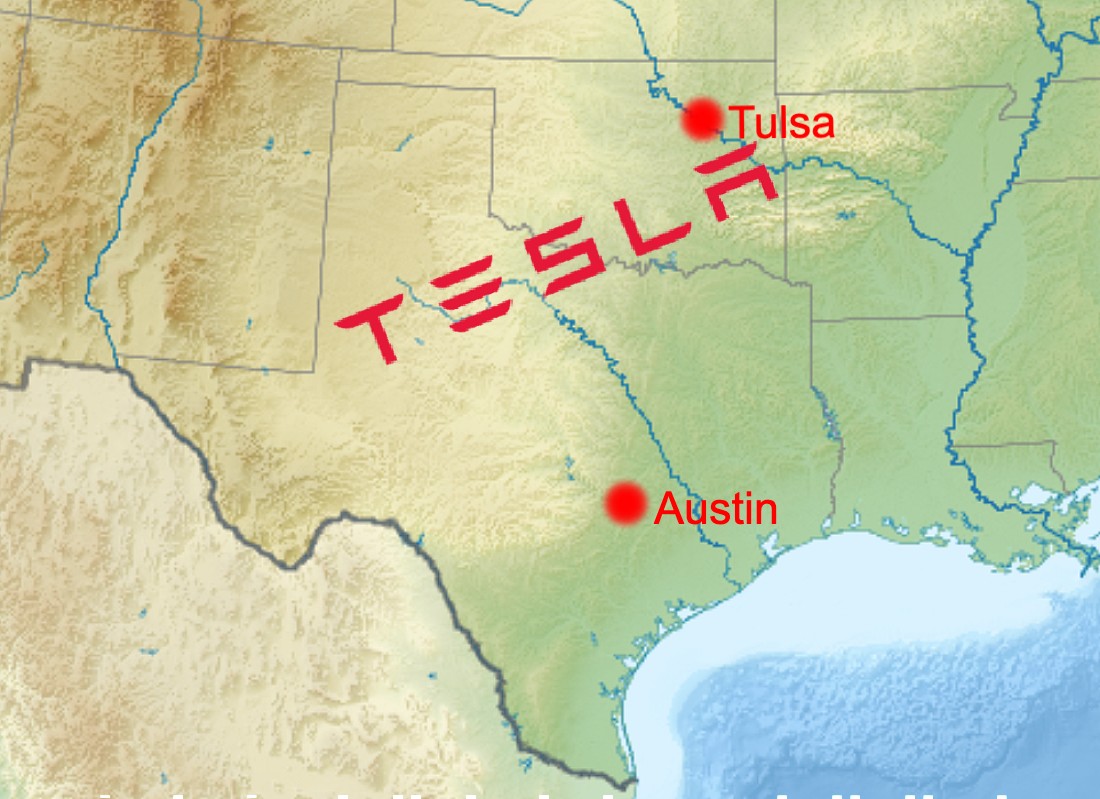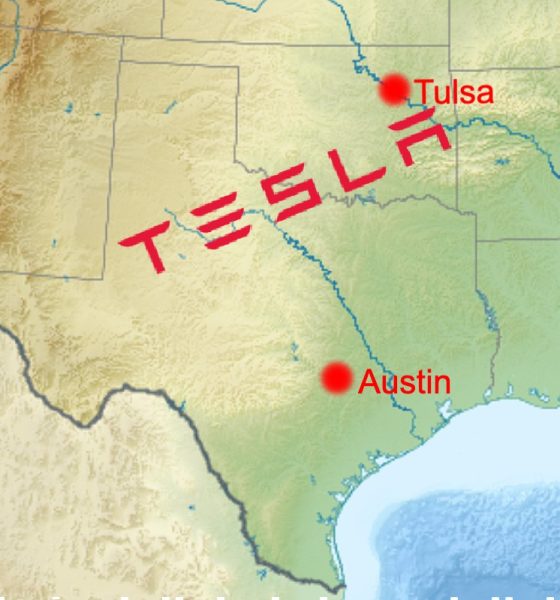

Investor's Corner
Tesla has its heart set on Texas for upcoming Cybertruck Terafactory
Tesla will likely select Austin, Texas as the location for its next Cybertruck Gigafactory, but that doesn’t mean they’ll turn down offers from other regions that are vying for their attention, including Tulsa, Oklahoma.
First reported by Electrek, and later confirmed by Teslarati with multiple sources, Texas is the forerunner to become home to the company’s next US factory.
The Elon Musk-led electric carmaker has been scouting for land in the outskirts of Austin and in nearby Taylor, roughly 30 miles northeast of the city, since earlier this year. While there have been no property sale records that link back to Tesla or an entity related to the company, sources tell Teslarati that the company is considering the acquisition of several large parcels of land near the industrial zones in Taylor.
Indicators that Tesla was considering Texas as the site for its next US-based Gigafactory grew stronger in February when CEO Elon Musk tweeted a poll that teased the question, “Giga Texas?”
Musk would later confirm, in March, the company’s desire for a Cybertruck Gigafactory that will be located closer to the east coast than California.
And last week, the company held talks with politicians in the Lone Star State, as confirmed by Texas Governor Greg Abbott.
“It’s true,” Abbott said over Twitter. “Texas is a perfect fit for Tesla.”
“I’ve had the opportunity to talk to Elon Musk, and he’s genuinely interested in Texas and genuinely frustrated with California. We’ve just got to wait and see how things play out,” the Texas Governor said in an interview with a local television station.
Other cities in Texas, like Fort Worth and Houston, have also welcomed Tesla by making suggestions to bring car manufacturing into their region. Houston stated that Musk could consolidate Tesla and SpaceX operations in its city, according to Mayor Sylvester Turner.
“As we continue our industrial evolution, I invite you to play a leading role in our story. As the only market that can immediately meet the production needs of Tesla and SpaceX, Houston provides a single solution for your operations,” Turner wrote. “Houston offers a broad innovative ecosystem in which industries coverage to solve the world’s greatest challenges in energy, manufacturing, logistics, and space.”
.@elonmusk Houston offers the #CompleteSolution to consolidate @Tesla and @SpaceX operations in one region. Join a city of innovators working to make the world better—just like you. #youbELONginHOU #HOUxTESLA
Read more here https://t.co/292AUyjW7Q pic.twitter.com/GhUZTPGvLs
— Houston Mayor's Office (@houmayor) May 15, 2020
Tesla’s next Gigafactory in the Central US will be geared toward the mass production of its upcoming Cybertruck, and the production of its Model Y crossover for the East Coast market.
While all indicators point to Austin, Texas as being the site for the company’s Cybertruck Gigafactory, a source tells Teslarati that the company is also considering another central U.S. location that’s 450 miles north of Austin: Tusla, Oklahoma.
Recently, State Representative Ryan Martinez and Governor Kevin Stitt invited Tesla to come to the Sooner State.
“Oklahoma is a wonderful place to do business. We’ve got a low tax base, a low cost of living, great incentives and services, and plenty of space to build a manufacturing headquarters and house all of your people,” Martinez said.
Texas appears to be the favorite in the race to become home to Tesla’s next US factory, however, the largely rural areas of Tulsa is also being considered as a region for its manufacturing facility. By having Tulsa in the conversation, along with other states that continue to court the company, Tesla can only benefit through increased leverage in its negotiations for local incentives.
With economic activity taking a massive blow in the face of the ever-changing pandemic, local governments need the economic boom that a Tesla Gigafactory can otherwise spark for the region.
And with Musk at the helm, who’s no stranger to walking the cashflow tightrope and striking at a good deal when it presents itself, rest assured that there’s going to be plenty of FOMO among state politicians before Tesla ultimately picks Texas.

Investor's Corner
Tesla stock closes at all-time high on heels of Robotaxi progress

Tesla stock (NASDAQ: TSLA) closed at an all-time high on Tuesday, jumping over 3 percent during the day and finishing at $489.88.
The price beats the previous record close, which was $479.86.
Shares have had a crazy year, dipping more than 40 percent from the start of the year. The stock then started to recover once again around late April, when its price started to climb back up from the low $200 level.
This week, Tesla started to climb toward its highest levels ever, as it was revealed on Sunday that the company was testing driverless Robotaxis in Austin. The spike in value pushed the company’s valuation to $1.63 trillion.
Tesla Robotaxi goes driverless as Musk confirms Safety Monitor removal testing
It is the seventh-most valuable company on the market currently, trailing Nvidia, Apple, Alphabet (Google), Microsoft, Amazon, and Meta.
Shares closed up $14.57 today, up over 3 percent.
The stock has gone through a lot this year, as previously mentioned. Shares tumbled in Q1 due to CEO Elon Musk’s involvement with the Department of Government Efficiency (DOGE), which pulled his attention away from his companies and left a major overhang on their valuations.
However, things started to rebound halfway through the year, and as the government started to phase out the $7,500 tax credit, demand spiked as consumers tried to take advantage of it.
Q3 deliveries were the highest in company history, and Tesla responded to the loss of the tax credit with the launch of the Model 3 and Model Y Standard.
Additionally, analysts have announced high expectations this week for the company on Wall Street as Robotaxi continues to be the focus. With autonomy within Tesla’s sights, things are moving in the direction of Robotaxi being a major catalyst for growth on the Street in the coming year.
Elon Musk
Tesla needs to come through on this one Robotaxi metric, analyst says
“We think the key focus from here will be how fast Tesla can scale driverless operations (including if Tesla’s approach to software/hardware allows it to scale significantly faster than competitors, as the company has argued), and on profitability.”

Tesla needs to come through on this one Robotaxi metric, Mark Delaney of Goldman Sachs says.
Tesla is in the process of rolling out its Robotaxi platform to areas outside of Austin and the California Bay Area. It has plans to launch in five additional cities, including Houston, Dallas, Miami, Las Vegas, and Phoenix.
However, the company’s expansion is not what the focus needs to be, according to Delaney. It’s the speed of deployment.
The analyst said:
“We think the key focus from here will be how fast Tesla can scale driverless operations (including if Tesla’s approach to software/hardware allows it to scale significantly faster than competitors, as the company has argued), and on profitability.”
Profitability will come as the Robotaxi fleet expands. Making that money will be dependent on when Tesla can initiate rides in more areas, giving more customers access to the program.
There are some additional things that the company needs to make happen ahead of the major Robotaxi expansion, one of those things is launching driverless rides in Austin, the first city in which it launched the program.
This week, Tesla started testing driverless Robotaxi rides in Austin, as two different Model Y units were spotted with no occupants, a huge step in the company’s plans for the ride-sharing platform.
Tesla Robotaxi goes driverless as Musk confirms Safety Monitor removal testing
CEO Elon Musk has been hoping to remove Safety Monitors from Robotaxis in Austin for several months, first mentioning the plan to have them out by the end of 2025 in September. He confirmed on Sunday that Tesla had officially removed vehicle occupants and started testing truly unsupervised rides.
Although Safety Monitors in Austin have been sitting in the passenger’s seat, they have still had the ability to override things in case of an emergency. After all, the ultimate goal was safety and avoiding any accidents or injuries.
Goldman Sachs reiterated its ‘Neutral’ rating and its $400 price target. Delaney said, “Tesla is making progress with its autonomous technology,” and recent developments make it evident that this is true.
Investor's Corner
Tesla gets bold Robotaxi prediction from Wall Street firm
Last week, Andrew Percoco took over Tesla analysis for Morgan Stanley from Adam Jonas, who covered the stock for years. Percoco seems to be less optimistic and bullish on Tesla shares, while still being fair and balanced in his analysis.

Tesla (NASDAQ: TSLA) received a bold Robotaxi prediction from Morgan Stanley, which anticipates a dramatic increase in the size of the company’s autonomous ride-hailing suite in the coming years.
Last week, Andrew Percoco took over Tesla analysis for Morgan Stanley from Adam Jonas, who covered the stock for years. Percoco seems to be less optimistic and bullish on Tesla shares, while still being fair and balanced in his analysis.
Percoco dug into the Robotaxi fleet and its expansion in the coming years in his latest note, released on Tuesday. The firm expects Tesla to increase the Robotaxi fleet size to 1,000 vehicles in 2026. However, that’s small-scale compared to what they expect from Tesla in a decade.
Tesla expands Robotaxi app access once again, this time on a global scale
By 2035, Morgan Stanley believes there will be one million Robotaxis on the road across multiple cities, a major jump and a considerable fleet size. We assume this means the fleet of vehicles Tesla will operate internally, and not including passenger-owned vehicles that could be added through software updates.
He also listed three specific catalysts that investors should pay attention to, as these will represent the company being on track to achieve its Robotaxi dreams:
- Opening Robotaxi to the public without a Safety Monitor. Timing is unclear, but it appears that Tesla is getting closer by the day.
- Improvement in safety metrics without the Safety Monitor. Tesla’s ability to improve its safety metrics as it scales miles driven without the Safety Monitor is imperative as it looks to scale in new states and cities in 2026.
- Cybercab start of production, targeted for April 2026. Tesla’s Cybercab is a purpose-built vehicle (no steering wheel or pedals, only two seats) that is expected to be produced through its state-of-the-art unboxed manufacturing process, offering further cost reductions and thus accelerating adoption over time.
Robotaxi stands to be one of Tesla’s most significant revenue contributors, especially as the company plans to continue expanding its ride-hailing service across the world in the coming years.
Its current deployment strategy is controlled and conservative to avoid any drastic and potentially program-ruining incidents.
So far, the program, which is active in Austin and the California Bay Area, has been widely successful.








